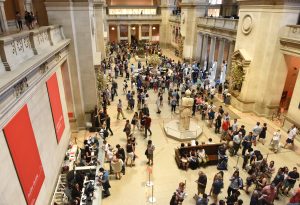In 1992, the Metropolitan Museum of Art in New York City purchased a rare Cambodian sculpture from an art dealer in Bangkok. “The Bodhisattva Avalokiteshvara Seated in Royal Ease” is a masterpiece of metal sculpting from the Angkorian period. But the 10th-century artifact was recently embroiled in a very 21st-century kerfuffle. Cambodia claims the artifact and eight other objects in Gallery 249 at the Met were pillaged from ancient sites. The case is part of a decade-long investigation into one of the most audacious international art capers.
Museums like the Met have rigorous systems to safeguard the institution from art fraud. But were the acquisitions of Cambodian artifacts tainted by competing interests?
One of the museum’s primary suppliers of Southeast Asian art was the Bangkok-based dealer Douglas Latchford. He was also a prolific art smuggler, but his public persona as a scholar camouflaged his illicit activities. A leading authority on Khmer art, Latchford showcased rarely-seen masterpieces in three widely-referenced books filled with glossy photographs. The books burnished his reputation as an expert while also whitewashing the artifact’s origins before they were placed on the international market. Latchford was indicted for antiquities trafficking shortly before his death in 2019.
“A key strategy for Latchford was cultivating relationships with museums,” author and art scholar Angela Chiu explained in an interview with the Washington, D.C.-based Antiquities Coalition.
Latchford sold his first artifacts to the Met in the early 1980s as the museum was starting to expand its South and Southeast Asian galleries. Martin Lerner, the curator for the region, developed a close professional relationship with Latchford in his quest to build a world-class collection. When the museum purchased the Avalokiteshvara, Lerner described the piece as “one of the finest and most important of the very few surviving major bronze sculptures of the Angkor period.” Latchford donated several works in Lerner’s honor, including two imposing stone statues called “Kneeling Attendants.” After his tenure at the museum ended, Lerner worked with Latchford as an art consultant.
The decades-long association, which continued even while Latchford was under investigation, has raised eyebrows. A lawyer for the Cambodian government told The New York Times his client was “eager to learn more about this relationship.”
Lerner admitted in a recent interview that relying on the “goodwill and integrity” of art dealers was a mistake. “Knowing what I know now, I should probably not have worked so closely with Mr. Latchford.”
Back in the 1980s, museums and collectors were willing to turn a blind eye to artifacts’ provenance and ownership history when their country of origin was politically unstable. Latchford frequently painted himself as a savior of Cambodia’s cultural heritage. He reportedly told The Bangkok Post in 2010 that large statues “would likely have been shot up for target practice by the Khmer Rouge” had they not been shipped out of the country.
Recent investigative reports give credence to the Cambodian government’s claim that the bronze and other pieces in Gallery 249 were illegally removed from the country. After the fall of the Khmer Rouge in 1979, the threat of land mines discouraged scholars from visiting archeological sites, leaving them open to looters. A former soldier turned temple raider reportedly unearthed the Avalokiteshvara using a metal detector. He stowed the bronze in a backpack and transported it by motor scooter to an intermediary in Siem Reap. Photographs on Latchford’s computer show the dirt-encrusted statue undergoing restoration in a workshop prior to its sale.
“It surprises me and disappoints me that there are so many statues of ours in the Met,” Cambodia’s Minister of Culture and Fine Arts Phoeurng Sackona said in an interview last year.
But Phnom Penh officials, who wholeheartedly embraced Latchford in his role as collector-philanthropist, are not entirely blameless. In 2008, Cambodia granted him the equivalent of a knighthood for his donations to state museums and invited him to become a citizen.
In a statement last year, the Met said that it had “a long and well-documented history of . . . being transparent about the provenance of works in the collection.” Notably, the Met has sent back some of Latchford’s gifts: the “Kneeling Attendants” were repatriated in 2013. Still, the museum has rejected Cambodia’s request to review internal documents related to the purchase of the artifacts.
However, revelations in the leaked trove of documents known as the Pandora Papers may have put the Met in an awkward spot. The leaked documents contain details on Latchford’s finances, including his use of secret offshore trusts. The museum reportedly contacted officials investigating the Latchford case with “new information” following the expose.
The New York Office of the U.S. Department of Homeland Security is eager to wrap up the long-running Latchford case. Their goal, one official said, was to ensure that “each piece of history is not just found, but sent home.”
Last month collector James H. Clark, the founder of Netscape, returned several pieces purchased from Latchford. The shipment included a monumental four-ton statue of the Hindu god, Ganesha.
Will the Met follow suit? Cambodia hopes it will.
“The Met sets the standards for other museums,” said their lawyer.

































